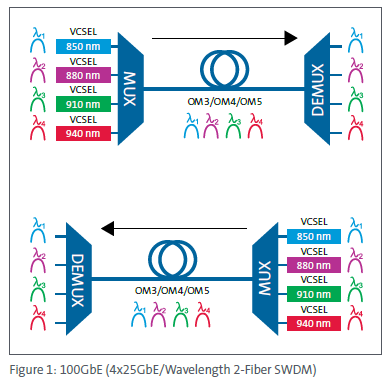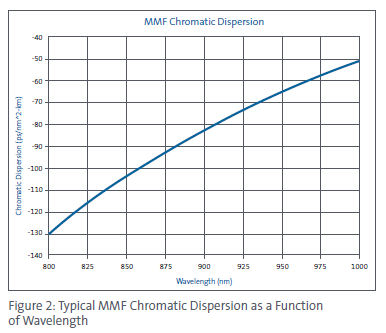What’s the Deal with OM5 Cable Standards – WBMMF?
April 19, 2017 / General, Standard and Certification, Industrial Networks
Guest Posting from Corning Optical Communications
OM5, previously known as wide band multimode fiber or WB MMF, has been quite the hot-button topic as the standards have been widely debated and are now finally concrete.
So what is OM5 exactly? Most simply, it’s a version of the OM4 fiber with additional bandwidth characterization at 953 nm.
But of course, that’s not all.
What’s new in standards?
Telecommunications Industry Association (TIA) initiated a workgroup in October 2014 to develop guidance for a wide band multimode fiber (WBMMF) 50/125 μm standard to support short wavelength division multiplexing (SWDM) transmission. The TIA-492AAAE Standard was published in June 2016. The IEC WB MMF standard is anticipated to be completed by early 2017.
What is different about OM5?
The OM5 optical and mechanical attributes are compliant with OM4 50/125 μm specifications and include the additional specifications of effective modal bandwidth and attenuation at 953 nm. WB MMF is intended for operation using vertical-cavity surface-emitting laser (VCSEL) transceivers across the 846 to 953 nm wavelength range.
What is SWDM?
SWDM is a proprietary wavelength division multiplexing (WDM) technology that uses four wavelengths across the 850 to 940 nm range. SWDM transceivers were designed to use 2-fiber connectivity into the transceiver with OM3/OM4. SWDM VCSEL transceivers are expected to be commercialized throughout 2017. See figure 1.

Can SWDM be used over OM5?
Yes. SWDM transceivers are compatible with OM3/OM4/OM5 optical connectivity solutions.
What are the expected SWDM data rates and distances?
The 40/100GbE expected maximum operational distances are given in the table below.
| OM3 | OM4 | OM5 | |
| 40G SWDM | 240 m | 350 m | 440 m |
| 100G SWDM | 75 m | 100 m | 150 m |
What are the specified OM5 effective modal bandwidth (EMB) values?
EMB ≥ 4700 MHz・km at 850 nm
EMB ≥ 2470 MHz・km at 953 nm
How do OM3/OM4 EMB values compare to OM5?
EMB is specified only at 850 nm for OM3/OM4 at 2000/4700 MHz・km, respectively. OM5 EMB values are specified at both 850 and 953 nm.
Why is the OM5 EMB lower at 953 nm compared to 850 nm?
The best system performance is achieved by a combination of low chromatic dispersion and high EMB. For typical optical fiber, the ideal zero dispersion wavelength occurs at 1310 nm. Because 953 nm is closer to 1310 nm than 850 nm, the chromatic dispersion is lower and consequently the EMB requirement is lower to achieve the same system performance as shown below

Is OM5 specified in optical transmission standards such as Ethernet and Fibre Channel?
There are no transmission standards that specify OM5 or SWDM. Transmission standards typically include only one multimode fiber variant that is selected based on economic, commercial, and technical criteria. Parallel transmission is the default multimode fiber variant for data rates ≥ 40G.
What cable jacket color will be used for OM5?
TIA has specified lime green as the official cable jacket color for OM5.
Does this new technology require a new polarity method for the duplex fiber connectivity?
No. Traditional Corning universal polarity connectivity solutions can be used. End users are expected to deploy solutions with Base-8 or Base-12 MTPR backbone cables and MTP-to-LC modules or harnesses to breakout into 2-fiber LC interconnects.
Will field channel loss measurements be required at both 850 and 953 nm?
No. Compliant 850 nm field channel loss measurements can be used to demonstrate 953 nm channel loss conformance. (For more on this topic, see Wide Band Multimode Fiber – An Update by Fluke Networks)
Can BiDi transceivers be used with OM5?
Yes. Corning Optical Communications’ EDGE and EDGE8 solutions with OM4 and OM5 have the same 40G BiDi 200 m distance capability.




